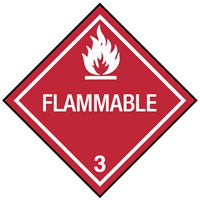
 Print
Print
Chemical Datasheet
AMYL NITRATE |

|
Chemical Identifiers
| CAS Number |
UN/NA Number |
DOT Hazard Label |
USCG CHRIS Code |
- 1002-16-0

|
|
|
|
| NIOSH Pocket Guide |
International Chem Safety Card |
|
none
|
none
|
NFPA 704
General Description
A clear colorless liquid with an ether-like odor. Flash point 118°F. About the same density as water and insoluble in water. Vapors heavier than air. Produces toxic oxides of nitrogen during combustion. Used as an additive for diesel fuels.
Hazards
Reactivity Alerts
- Highly Flammable
- Strong Oxidizing Agent
Air & Water Reactions
Flammable. Insoluble in water.
Fire Hazard
Special Hazards of Combustion Products: Toxic oxides of nitrogen may form in a fire.
Behavior in Fire: Overheated material may detonate. (USCG, 1999)
Health Hazard
Inhalation or ingestion may cause headache, methemoglobin, and nausea. Liquid and vapor irritate eyes. Contact with skin may cause slight irritation. (USCG, 1999)
Reactivity Profile
AMYL NITRATE is an oxidizing reagent. When exposed to heat or flame it may decompose to form nitrogen oxides. Accelerates the burning of combustible materials. Can produce a violent reaction with reducing materials [Sax, 9th ed., p. 228].
Belongs to the Following Reactive Group(s)
- Nitro, Nitroso, Nitrate, and Nitrite Compounds, Organic
Potentially Incompatible Absorbents
Use caution: Liquids with this reactive group classification have been
known to react with the
absorbents
listed below.
- Cellulose-Based Absorbents
- Expanded Polymeric Absorbents
Response Recommendations
Isolation and Evacuation
Excerpt from ERG Guide 128 [Flammable Liquids (Water-Immiscible)]:
IMMEDIATE PRECAUTIONARY MEASURE: Isolate spill or leak area for at least 50 meters (150 feet) in all directions.
LARGE SPILL: Consider initial downwind evacuation for at least 300 meters (1000 feet).
FIRE: If tank, rail tank car or highway tank is involved in a fire, ISOLATE for 800 meters (1/2 mile) in all directions; also, consider initial evacuation for 800 meters (1/2 mile) in all directions. (ERG, 2024)
Firefighting
Excerpt from ERG Guide 128 [Flammable Liquids (Water-Immiscible)]:
CAUTION: The majority of these products have a very low flash point. Use of water spray when fighting fire may be inefficient. CAUTION: For mixtures containing alcohol or polar solvent, alcohol-resistant foam may be more effective.
SMALL FIRE: Dry chemical, CO2, water spray or regular foam. If regular foam is ineffective or unavailable, use alcohol-resistant foam.
LARGE FIRE: Water spray, fog or regular foam. If regular foam is ineffective or unavailable, use alcohol-resistant foam. Avoid aiming straight or solid streams directly onto the product. If it can be done safely, move undamaged containers away from the area around the fire.
FIRE INVOLVING TANKS, RAIL TANK CARS OR HIGHWAY TANKS: Fight fire from maximum distance or use unmanned master stream devices or monitor nozzles. Cool containers with flooding quantities of water until well after fire is out. For petroleum crude oil, do not spray water directly into a breached tank car. This can lead to a dangerous boil over. Withdraw immediately in case of rising sound from venting safety devices or discoloration of tank. ALWAYS stay away from tanks in direct contact with flames. For massive fire, use unmanned master stream devices or monitor nozzles; if this is impossible, withdraw from area and let fire burn. (ERG, 2024)
Non-Fire Response
Excerpt from ERG Guide 128 [Flammable Liquids (Water-Immiscible)]:
ELIMINATE all ignition sources (no smoking, flares, sparks or flames) from immediate area. All equipment used when handling the product must be grounded. Do not touch or walk through spilled material. Stop leak if you can do it without risk. Prevent entry into waterways, sewers, basements or confined areas. A vapor-suppressing foam may be used to reduce vapors. Absorb or cover with dry earth, sand or other non-combustible material and transfer to containers. Use clean, non-sparking tools to collect absorbed material.
LARGE SPILL: Dike far ahead of liquid spill for later disposal. Water spray may reduce vapor, but may not prevent ignition in closed spaces. (ERG, 2024)
Protective Clothing
Respirator with canister for vapors at high concentrations (USCG, 1999)
DuPont Tychem® Suit Fabrics
No information available.
First Aid
INHALATION: move to fresh air; support respiration; get medical attention.
INGESTION: induce vomiting; get medical attention.
EYES: irrigate thoroughly with water.
SKIN: wash with soap and water. (USCG, 1999)
Physical Properties
Flash Point:
120°F
(USCG, 1999)
Lower Explosive Limit (LEL): data unavailable
Upper Explosive Limit (UEL): data unavailable
Autoignition Temperature: data unavailable
Melting Point:
-190°F
(USCG, 1999)
Vapor Pressure: data unavailable
Vapor Density (Relative to Air): data unavailable
Specific Gravity:
1
at 68°F
(USCG, 1999)
Boiling Point:
292 to 314°F
at 760 mmHg
(USCG, 1999)
Molecular Weight:
133
(USCG, 1999)
Water Solubility: data unavailable
Ionization Energy/Potential: data unavailable
IDLH: data unavailable
AEGLs (Acute Exposure Guideline Levels)
No AEGL information available.
ERPGs (Emergency Response Planning Guidelines)
No ERPG information available.
PACs (Protective Action Criteria)
| Chemical |
PAC-1 |
PAC-2 |
PAC-3 |
| Nitric acid, pentyl ester; (Amyl nitrate) (1002-16-0)
|
1.4 ppm |
16 ppm |
93 ppm |
(DOE, 2024)
Regulatory Information
EPA Consolidated List of Lists
No regulatory information available.
CISA Chemical Facility Anti-Terrorism Standards (CFATS)
No regulatory information available.
OSHA Process Safety Management (PSM) Standard List
No regulatory information available.
Alternate Chemical Names
- AMYL NITRATE
- AMYL NITRATE (MIXED ISOMERS)
- DIESEL IGNITION IMPROVER
- MIXED PRIMARY AMYL NITRATES
- N-AMYL NITRATE
- N-PENTYL NITRATE
- PENTYL NITRATE
- 1-PENTYL NITRATE


 Print
Print
